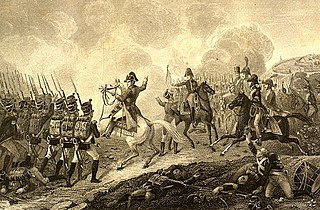
In the Battle of Lützen, Napoleon I of France halted the advances of the Sixth Coalition after the French invasion of Russia and the massive French losses in the campaign. The Russian commander, Prince Peter Wittgenstein, attempting to forestall Napoleon's capture of Leipzig, attacked the isolated French right wing near Lützen, Germany. After a day of heavy fighting, the combined Prussian and Russian force retreated; due to French losses and a shortage of French cavalry, Napoleon was unable to conduct a pursuit.

In the Battle of Bautzen, a combined Russian–Prussian army, that was massively outnumbered, was pushed back by Napoleon I of France but escaped destruction, some sources claiming that Michel Ney failed to block their retreat. The Prussians under Count Gebhard von Blücher and Russians under Prince Peter Wittgenstein, retreating after their defeat at Lützen were attacked by French forces under Napoleon.

The Spree is a river that flows through the Saxony, Brandenburg and Berlin states of Germany, and in the Ústí nad Labem region of the Czech Republic. Approximately 400 kilometres (250 mi) in length, it is a left bank tributary of the River Havel, which itself flows into the Elbe and then the North Sea. It is the river on which the original centre of Berlin was built.
The district of Bautzen is a district in the state of Saxony in Germany. Its largest towns are Bautzen, Bischofswerda, Kamenz, Hoyerswerda and Radeberg. It is the biggest district in Saxony by area, and a member of the Neisse Euroregion.

Bautzen is a hill-top town in eastern Saxony, Germany, and administrative centre of the eponymous district. It is located on the Spree. In 2018 its population was 39,087.
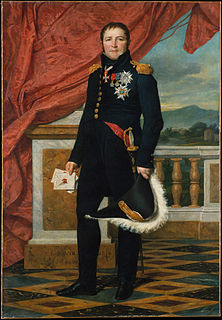
Étienne Maurice Gérard, 1er Comte Gérard was a French general, statesman and Marshal of France. He served under a succession of French governments including the ancien regime monarchy, the Revolutionary governments, the Restorations, the July Monarchy, the First and Second Republics, and the First Empire, becoming Prime Minister briefly in 1834.
The Fallschirm-Panzer-Division 1. Hermann Göring was an elite German Luftwaffe armoured division. The HG saw action in North Africa, Sicily, Italy and on the Eastern Front. The division began as a battalion-sized police unit in 1933. Over time it grew into a regiment, brigade, division, and finally was combined with the Parachute-Panzer Division 2 Hermann Göring on May 1, 1944 to form a Panzer corps under the by then Reichsmarschall. It surrendered to the Soviet Army near Dresden on May 8, 1945.

Upper Lusatia is a historical region in Germany and Poland. Along with Lower Lusatia to the north, it makes up the region of Lusatia, named after the Slavic Lusici tribe. Both Lusatias are home to the West Slavic minority group of the Sorbs.

Hochkirch is a municipality in the district of Bautzen, in Saxony, Germany. It is known for the 1758 Battle of Hochkirch, part of the Seven Years' War.
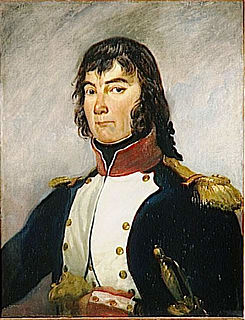
Georges Mouton, comte de Lobau was a French soldier and political figure who rose to the rank of Marshal of France.

The Battle of Bautzen was one of the last battles of the Eastern Front during World War II. It was fought on the extreme southern flank of the Spremberg-Torgau Offensive, seeing days of pitched street fighting between forces of the Polish Second Army under elements of the Soviet 52nd Army and 5th Guards Army on one side and elements of German Army Group Center in the form of the remnants of the 4th Panzer and 17th armies on the other.
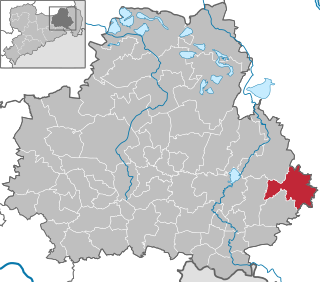
Weißenberg is a town in the district of Bautzen, in the Free State of Saxony, Germany. It is located 11 km north of Löbau, and 16 km east of Bautzen.

Neukirch/Lausitz is a municipality in upper Lusatia (Lausitz) in the district of Bautzen in Saxony in eastern Germany. It belongs to the district of Bautzen and is situated in several valleys of the mountain region Lausitzer Bergland near the hill "Valtenberg" that reaches about 587 metres. It has about 5,066 inhabitants in an area of 21.32 km², a population density of 240 per km².
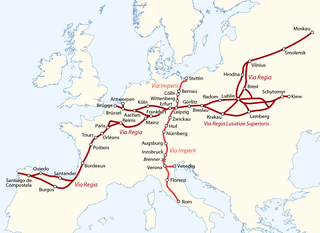
The Via Regia - is a European Cultural Route following the route of the historic road of the Middle Ages.
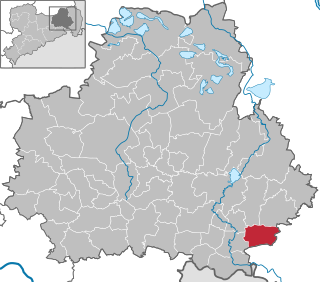
Cunewalde or in the Sorbian language Kumwałd is a community in the district of Bautzen in the east of the federal Free State of Saxony in Germany. It lies between the cities of Bautzen and Löbau in a valley between the hills of the Czorneboh, the Hochstein and the Bieleboh, all part of the northernmost mountain ranges of the Lusatian Highlands. It is one of the more populous villages in Upper Lusatia and the longest street village in all of Germany.
The Polish Second Army was a Polish Army unit formed in the Soviet Union in 1944 as part of the People's Army of Poland. The organization begun in August under the command of generals Karol Świerczewski and Stanislav Poplavsky, and the formation under command of general Świerczewski entered active duty in January 1945. The Second Army suffered heavy losses at the Battle of Bautzen during April 22–26, 1945. Subsequently, the Second Army was part of the final great Soviet offensive of World War II in Europe, the drive on Prague. In August 1945 most of the formation was used to create the Poznań Military District.

The Fußballspielvereinigung Budissa Bautzen is a German association football club from Bautzen, Saxony. Founded as Fußballclub Budissa Bautzen on 24 May 1904, the club participated in East German football after World War II.
Events from the year 1813 in France.
The 52nd Army was a field army of the Red Army of the Soviet Union in World War II, formed twice.

Ernst Friedrich Giese was a German architect and university professor at the Düsseldorf Art Academy and at the Technical University of Dresden.














